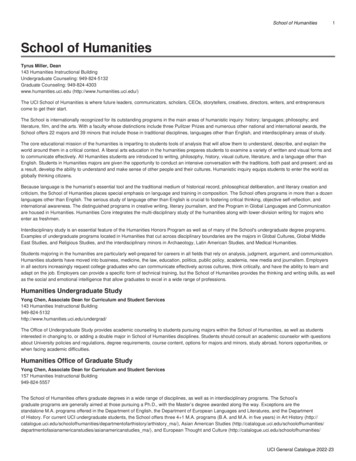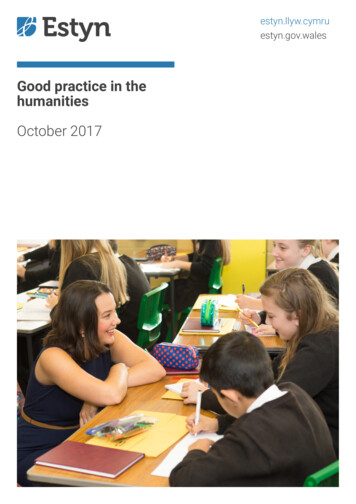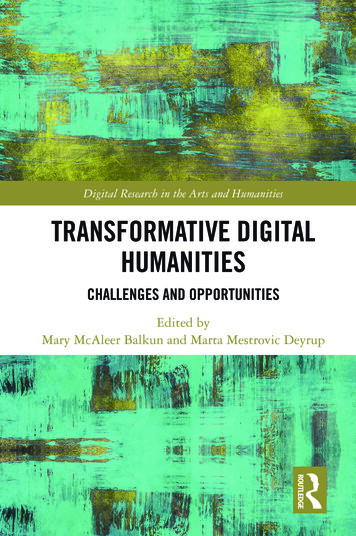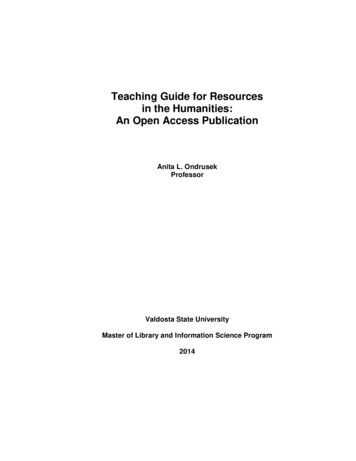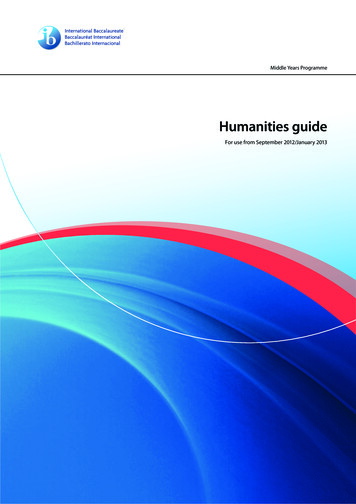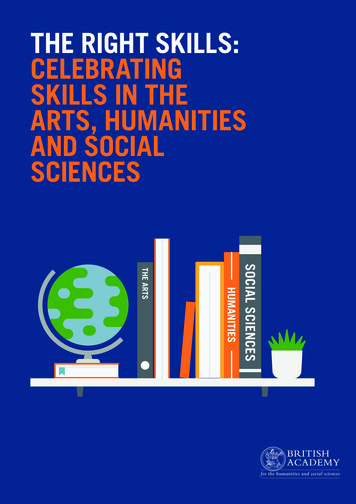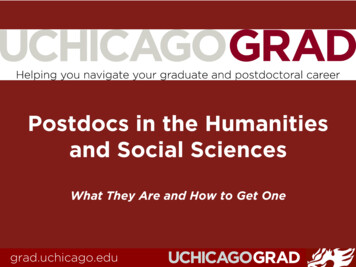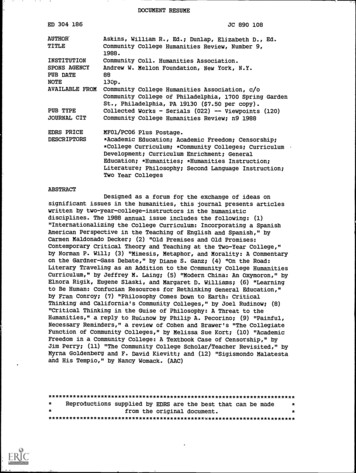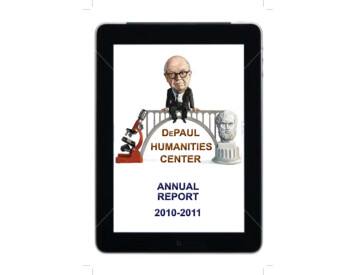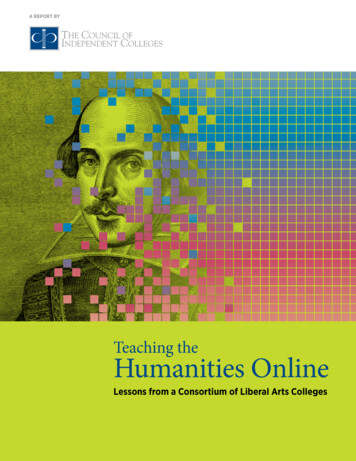
Transcription
A REPORT BYTeaching theHumanities OnlineLessons from a Consortium of Liberal Arts Colleges
2019 by the Council of Independent CollegesThe Council of Independent Colleges (CIC) is an association of 768 nonprofit independentcolleges and universities, state-based councils of independent colleges, and other highereducation affiliates, that works to support college and university leadership, advance institutional excellence, and enhance public understanding of independent higher education’scontributions to society. CIC is the major national organization that focuses on servicesto leaders of independent colleges and universities and state-based councils. CIC offersconferences, seminars, publications, and other programs and services that help institutionsimprove educational quality, administrative and financial performance, student outcomes,and institutional visibility. CIC conducts the largest annual conferences of college and university presidents and of chief academic officers in the United States. Founded in 1956,CIC is headquartered at One Dupont Circle in Washington, DC. For more information,visit www.cic.edu.AcknowledgementThe Andrew W. Mellon Foundation provided generous support for the Consortium forOnline Humanities Instruction.About the AuthorsThe principal authors of this report are Barbara Hetrick, CIC senior advisor and former CICsenior vice president, and Deanna Marcum, senior advisor to Ithaka S R’s program areas inEducational Transformation and Libraries and Scholarly Communication and previouslyIthaka S R managing director. Additional contributions were made by Philip M. Katz, CICdirector of projects.
Teaching theHumanities OnlineLessons from a Consortium of Liberal Arts CollegesA Report by the Council of Independent CollegesJuly 2019
1TEACHI NG THE HU MANI TI ES ONLI NETable of ContentsForeword by Bryan Alexander. . . . . . . . . . . . . . . . . . . . . . . . . . . . . . . . . . . . . . . . . . . . . . . . . . . . . . . . . . . . . . . . .2Background and Overview of the Consortia forOnline Humanities Instruction . . . . . . . . . . . . . . . . . . . . . . . . . . . . . . . . . . . . . . . . . . . . . . . . . . . . . . . . . . . . . . .6A Brief History. . . . . . . . . . . . . . . . . . . . . . . . . . . . . . . . . . . . . . . . . . . . . . . . . . . . . . . . . . . . . . . . . . . . . . . . . . . . . . . . . . .6Consortium I . . . . . . . . . . . . . . . . . . . . . . . . . . . . . . . . . . . . . . . . . . . . . . . . . . . . . . . . . . . . . . . . . . . . . . . . . . . . . . . . . . . .9Consortium II. . . . . . . . . . . . . . . . . . . . . . . . . . . . . . . . . . . . . . . . . . . . . . . . . . . . . . . . . . . . . . . . . . . . . . . . . . . . . . . . . . . .10Lessons Learned: Student Learning and Satisfaction. . . . . . . . . . . . . . . . . . . . . . . . . . . . . . . . . . . . . .15Lessons Learned: Teaching Outcomes and Faculty Perceptions. . . . . . . . . . . . . . . . . . . . . . . . .25Lessons Learned: Administration and Institutional Impact. . . . . . . . . . . . . . . . . . . . . . . . . . . . . .33Sustaining a Consortium . . . . . . . . . . . . . . . . . . . . . . . . . . . . . . . . . . . . . . . . . . . . . . . . . . . . . . . . . . . . . . . . . . . . . . .43Afterword: A Focus on Learning by Richard Ekman . . . . . . . . . . . . . . . . . . . . . . . . . . . . . . . . . . . . . .51Appendix A: Overview of Evaluation Design. . . . . . . . . . . . . . . . . . . . . . . . . . . . . . . . . . . . . . . . . . . . . . .53Appendix B: List of Courses Offered through the Consortia. . . . . . . . . . . . . . . . . . . . . . . . . . . . .56
2ForewordThese are challenging times for American highereducation, and that represents a significant breakfrom most of the nation’s post-World War II history.The postsecondary world has been greatly enhancedover the past generations. As others have observed,from the 1970s onward colleges and universitiesexpanded their curricula. The professoriate, staff, andstudents became gradually more diverse. Americanresearch output led and helped change the world. Partlyin response, more international students traveled to theUnited States while total enrollment surged to the highest levels in history.1Yet this institutional ascent ran into 21st-century obstacles. The 2008 financial panic, the resulting economicdownturn, and the slow, uneven recovery processtherefrom dealt many institutions severe blows, requiring years of painful adjustments. The expansion of thetotal student loan amount has yielded extensive mediacriticism and widespread anxiety about financing college. Richard Arum and Josipa Roksa’s controversialAcademically Adrift (2011) spurred additional concernsabout the quality of higher education. After decades ofgrowth, even a boom, total postsecondary enrollmentnumbers started to decline in 2012, driven largely bycommunity colleges’ countercyclical response to lowunemployment and the near collapse of the for-profitsector; however, students exiting those sectors havegenerally not moved on to the rest of higher education.Indeed, total enrollment numbers have yet to recoveras of this writing.Further stresses appeared as the 21st century rolled on.The Obama administration spent eight years trying toreform all of education, including colleges and universities, even in the face of opposition. Internationalenrollment ticked downward in the wake of Trumpadministration policies and school shootings, whileRepublican dislike of higher education grew andpopular suspicion of both learning and elites caughtfire. Technological innovations led some to proclaimthe disruption or doom of higher education, much asother industries had been upended by the continuousdigital revolution. A series of widely discussed institutional closures, mergers, and near-closures haveadded to the emerging narrative of a postsecondaryecosystem in danger. A spectacular admissions andathletics scandal in 2019 seemed to confirm manypublic concerns while undermining the sector’s reputation still further.1 Steven Brint, Two Cheers for Higher Education: Why American Universities Are Stronger Than Ever—and How toMeet the Challenges They Face (Princeton: Princeton University Press, 2019); Clay Shirky, “The End of HigherEducation’s Golden Age,” blog post (January 29, 2014, accessed March 29, 2019): .
TEACHI NG THE HU MANI TI ES ONLI NEPrivate colleges and universities face particular pressures in this moment. Anxieties about (published)tuition and student loan debt often attach to thissector, especially as new or expanded state government plans to support public higher education tuitiongive that sector a competitive edge over private campuses. Private campuses also are very well representedin northeastern and midwestern states—precisely theregions suffering the most acutely from a demographicreduction in the teenage population. Those demographics are likely to worsen over the next decade.2Further, cultural charges of elitism are far more likelyto adhere to private institutions than to public ones. Atthe same time, the financial model of tuition discounting has pushed some discount rates above 50 percent,which some experts deem unsustainable.In this dark era, the humanities bear an especially heavyburden. Enrollment patterns over the past two decadeshave tended toward higher numbers for other fields,namely STEM and business, but the past several yearshave seen the humanities hit harder than they havebeen for generations. Benjamin Schmidt and othershave established that arts, law, philosophy, English language and literature, history, and religion enrollmentshave suffered a serious and sustained downturn in thewake of the 2008 financial crash.3 Graduate programsin law, that well-trodden path for humanities graduates,have fallen back to 1970s levels. It seems that students,increasingly concerned with employment and seeingthe humanities as ill-suited for that goal, are votingwith their feet.In such a context, we must sometimes struggle to findoptimism about the fate of the humanities in privatecolleges and universities. Despite that, the pages thatfollow offer precisely this kind of positive news. Inthe face of gloomy forecasts, they describe a bold andambitious project to use technology across campuses togive new life to upper-level humanities courses.Over several years, a group of colleges and universities brought together by the Council of IndependentColleges developed an unusual program, an interinstitutional collaborative structure wherein onecampus taught a humanities course, and students atother campuses could take it. Participating institutionsformed consortia to support these exchanges, withmultiple courses being taught among them.Leading such collaborations required a series of innovations and experiments. Classes had to be redesignedto account for, and to maximize the benefits of, thisnew setting. These were hybrid classes, combining faceto-face with online learning, so pedagogies needed tobe adjusted, drawing on the past generation of digitalteaching and learning research. Campus technologistsassisted faculty members and their departments in thisprocess. Appropriate technologies were selected, tested,and assessed. Curricular committees and academicleadership had to study and approve course proposals, while registrars developed ways of accountingfor them. College and university teams studied theseclosely, as did outside experts, most notably IthakaS&R, seeking to develop and improve them throughsubsequent iterations.These consortia are unusual in several ways. They areneither wholly online nor entirely face-to-face, but asynthesis of those two modes. They are not MOOCs.They do not work at massive scale, but instead retainthe small class sizes prized by small colleges and universities. They represent active collaboration amongcampuses that might otherwise compete with each2 Nathan D. Grawe, Demographics and the Demand for Higher Education (Baltimore: Johns Hopkins University Press, 2018).3 Benjamin M. Schmidt, “The History BA Since the Great Recession: The 2018 AHA Majors Report,” American Historical Association(November 26, 2018, accessed March 29, 2019): ort.3
4T EAC H IN G T H E H UM A N IT IES ONLI NEother. Class topics do not involve technology or evenmedia studies, but are proud examples of classichumanistic inquiry: Byzantine art, the history of thebook, ethics, the American Civil War, Biblical prophetic texts, gender, and literature.In one sense these distributed, consortial courses arefine examples of private colleges and universities innovating boldly, practically, and at some degree of scale.They represent a finely tuned creative spirit withinacademia seeking to reinvent humanities teaching fora new era. As digital technologies invade and rebootmore of human society, these consortia carefully usedthose tools to power new ways of teaching. This is aterrific story, one well worth being told across all audiences interested in education.At the same time, the project is one that connectsdeeply with the history of the humanities. These classesare, in a sense, further instances of the pre-digital desireto connect scholars and students around the questionsand artifacts fundamental to the humanities. They offera new way for curious students to explore these topicsand for faculty members to inspire them. They are thehumanities through other means.Looking forward, such inter-campus teaching projectsmay offer a glimpse of the future. From the campusside, if many colleges and universities struggle withenrollment issues, opening up campus classes tostudents from other institutions gives them the opportunity to increase class sizes. In addition, since these areupper-level classes with particular topics, participating campuses can effectively expand their humanitiesofferings. This may be especially attractive to smallercolleges and universities, giving their students a greaternumber of curricular options to explore. Put anotherway, if present day humanities departments may beoverbuilt for current demand, inter-campus classes letthem expand that demand.Students are likely to express that demand digitally.Although it is easy to overstate or mythologize thereal world skills of “digital natives,” social trends haveestablished that younger people—the primary studentmarket for small, private colleges and universities—tend to be more thoroughly immersed in the digitalworld than their elders. They are more likely to usemore software and hardware. Inter-campus teachingcan meet those students where they live.At the same time, as skepticism, criticism, and outright fear of the contemporary digital world build,inter-campus teaching offers an alternative way ofengaging with technology. Instead of relying on SiliconValley giants that can violate user privacy and allowor encourage abuse, campuses can establish saferenvironments where faculty members and studentscan interact with peers in supportive environments.Preexisting policies and practices already attuned tostudent needs and safety can help structure positivelearning experiences.From a technological angle, consortial teaching requiresinstitutions to advance their academic computingcapacities. IT departments need first to establish infrastructural baselines to allow their faculty members andstudents to participate, supporting sufficient networking, hardware, and software needs. Instructional designstaff are needed to help faculty members translatetheir classes into this new form. Faculty developmentis required as well. Committing to the consortiummodel is a strategic investment, and one that couldpay dividends in many areas. The practice can inspireother faculty members to revise their classes, be theyentirely in the physical classroom or to some degreeonline. Each face-to-face consortial meeting I attendedsaw faculty members describing how the experience ofteaching students online helped them rethink their traditional classroom practices.
TEACHI NG THE HU MANI TI ES ONLI NEAs new technologies appear and (relatively) older onesare transformed, the consortium model describedin this report offers campuses a way to engage withthem. Practically, faculty and staff members candetermine the best ways to apprehend virtual reality,artificial intelligence, blockchain, and mixed reality.Meanwhile, campus populations can bring their critical capacities to bear, assessing the nature of thesetechnologies. Humanists are well positioned to contribute to such conversations, given the many insightsinto the digital world provided by history, philosophy,the arts, and other disciplines. The practical engagement of institutions through inter-campus teachingcan ground such discussions, while encouraginggreater participation in them. The consortium modelis, therefore, future oriented.How did campuses make this approach work? How didfaculty members shift their pedagogies and curricula?By what means did administrative leaders understandthe consortium model and support their faculty andstaff members in making it happen? How did studentsunderstand and react to these innovative and unusualclasses? How costly was the campus investment neededto bring the project to life? The pages that follow answerthose questions in extensive and thoughtful detail. Thereport offers a deep examination of how the projectplayed out in practice. It may afford a glimpse of thehumanities, and the private college and universityworld, to come.Bryan AlexanderBryan Alexander is principal of Bryan Alexander Consulting5
6Background and Overview of the Consortiafor Online Humanities InstructionA Brief HistoryOnly six years ago, MOOCs (massive open onlinecourses) dominated the discussion about digital teaching and learning in higher education. Unsurprisingly,the Council of Independent Colleges (CIC) becameinterested in understanding this new phenomenonand what it might mean for undergraduate learning,especially at smaller liberal arts institutions. CIC pursued two lines of inquiry. First, the staff consulted withMOOC providers to explore the idea of developingpartnerships between CIC member institutions andone or more providers of MOOCs. Second, the staffconsulted with the leaders of CIC member institutionsand learned that an explosion of spontaneous interestin online education already was taking place on campuses all over the country. In fact, a survey of CICmember institutions conducted by the Learning HouseInc. in 2012 revealed that 88 percent offered some formof online coursework, mostly in professional programsat the undergraduate and graduate levels. Only 18 percent had offerings in the humanities.The same survey asked chief academic officers todescribe the role they would like CIC to play in promoting online learning at independent colleges anduniversities. Nearly 90 percent said they wanted to learnmore about comparable institutions’ strategic uses ofonline learning; nearly 80 percent requested opportunities to share models and experiences; and nearly 70percent wanted to learn how to develop online coursesor programs. CIC staff concluded that online alternatives to large lecture courses such as MOOCs were ofmarginal relevance to the strategic needs of independent liberal arts institutions and that academic leaderswere anxious to learn how to develop and use their owncourses online as well as “how to use blended or hybridapproaches.” The 2014 Babson Survey confirmed thisinsight when it reported that 65 percent of academicleaders at private nonprofit colleges and universitiesindicated that “online education is critical to the longterm strategy of my institution,” while fewer than 14percent said they had or planned to introduce MOOCson campus.4CIC staff came to understand that online learningtechnologies have the potential to help CIC memberinstitutions address the problem of sustaining advancedcourses that often are essential to the integrity of liberalarts majors with small enrollments. Given the recentstruggles in college and university finances, manysmaller colleges have had a difficult time balancing4 I. Elaine Allen and Jeff Seaman, Grade Level: Tracking Online Education in the United States (Babson Survey Group, delevel.pdf.
TEACHI NG THE HU MANI TI ES ONLI NEbudgets and offering strong majors in liberal arts disciplines. This has been especially true in the humanities.Since the 2008 financial crisis, according to a recentarticle in the Atlantic, “Almost every humanities fieldhas seen a rapid drop in majors .” 5 This decline hasoccurred at all types of institutions of higher education. In addition, there is evidence that enrollmentin humanities courses also has declined, especially inupper-level courses, though not as precipitously as thenumber of majors. CIC thus decided to try to find waysto use new instructional technologies to improve student learning in advanced courses and lower costs bysharing resources and knowledge among institutions.Essentially, the goal was to improve and promote theupper-level courses in the humanities that are so valuable to a liberal arts education.CIC recognized the rapid pace of change in onlinelearning, how little was known about the efficacy ofvarious approaches to online teaching and learning,and declining enrollments in the humanities at all typesof colleges and universities, including many smallercolleges. Therefore, CIC approached the Andrew W.Mellon Foundation in 2013 for support of a project thatwould focus on the evaluation of student learning outcomes and instructional costs to assess the effectivenessof online and hybrid courses as feasible alternatives totraditional, often under-enrolled, upper-level coursesin the humanities. The foundation agreed, and CICselected 21 colleges and universities to participate inthe Consortium for Online Humanities Instruction.From the outset CIC regarded the project as a “naturalexperiment” and engaged Ithaka S R to evaluate allaspects of the Consortium.7Consortia for Online Humanities InstructionMember InstitutionsConsortium I (2014–2016)Consortium II (2016–2018)Augustana University (SD)Bloomfield College (NJ)Bethune-CookmanUniversity (FL)Carlow University (PA)Bucknell University (PA)Carroll University (WI)Concordia College (MN)Connecticut College(joint project)Elizabethtown College (PA)Gordon College (MA)Grand View University (IA)Hiram College (OH)Lesley University (MA)McDaniel College (MD)Moravian College (PA)Otterbein University (OH)Park University (MO)Saint Michael’s College (VT)Saint Vincent College (PA)Susquehanna University (PA)Sweet Briar College (VA)Trinity College (CT)(joint project)Carroll College (MT)Claflin University (SC)Clarke University (IA)Concordia University TexasGettysburg College (PA)Lasell College (MA)Mount Mary University (WI)Northwestern College (IA)Randolph-Macon College (VA)Rosemont College (PA)Shenandoah University (VA)Siena College (NY)Simpson College (IA)St. Edward’s University (TX)St. Olaf College (MN)Ursuline College (OH)Walsh University (OH)Wesleyan College (GA)University of St. Francis (IL)Wartburg College (IA)5 Benjamin Schmidt, “The Humanities Are in Crisis,” The Atlantic (August 23, 2018): nities-face-a-crisisof-confidence/567565.
8T EAC H IN G T H E H UM A N IT IES ONLI NECIC staff members were initially unsure of the extent ofinterest among independent colleges and universitiesin developing, offering, and accepting online coursesin the humanities. After all, small liberal arts collegestake great pride in the individual attention they givestudents and in the low student-to-faculty ratios andsmall class sizes they are able to offer. Moreover, facultymembers who teach humanities courses are among thestrongest believers in the value of in-class participationfor student learning. Therefore, it was a surprise thatnearly 100 institutions applied for inclusion in the firstConsortium and 42 applied to participate in the secondConsortium two years later. Adding upper-level courses from other institutionsmight enable students to major in a humanities discipline not currently available to them.Why were these institutions, including their humanities faculty members and administration, interested inparticipation in a consortium designed to share onlineupper-level courses in the humanities? Some of the reasons were general and might be true of participation inany national higher education project: Systematic participation could lead to less duplication of courses and programs among institutions. Association with a national project would bringvisibility to the institution and perhaps enhance itsreputation; Over time, participation in the project could helpthe institution become more distinctive in waysrelated to its goals and accomplishments; and Having courses available online could serve particular students and help them graduate on time:athletes, students studying abroad, adult students,employed students, and students pursuing internships off campus. Participation in the Consortium could help institutions maintain humanities disciplines that areessential to their missions. Participation might lead to cost savings.Finally, from a faculty perspective: The Consortium could provide opportunities toteach more courses in their area of specialization. The Consortium could help maintain faculty positions if full-time teaching loads were to include bothtraditional and online courses. Association with an online consortium of institutions throughout the country could demonstrate theinstitution’s willingness to stay current with trendsin higher education. Faculty members could learn from one anotherabout course development, approaches to teachingonline, course and teaching evaluation, and otherways to strengthen teaching as well as learning fromeach other’s successes and missteps.For administrators, this project also had a specificappeal: Faculty members might learn new pedagogies thatthey could use in traditional classes. Institutions could market more courses, majors orconcentrations, minors, and other programs to prospective students and their families and thus aid instudent recruitment. They could see the connections between their ownexperience with teaching and larger national issuesabout student learning.
TEACHI NG THE HU MANI TI ES ONLI NEConsortium IThe institutional teams participated in two workshops prior to the initial offering of online or hybridcourses in the humanities: a national workshop in July2014 and one of three regional workshops in October2014. These workshops provided opportunities forparticipants to hear from national experts in onlineinstruction and to address specific implementationissues, course evaluation practices, and the logistics ofthe Consortium. Each workshop also included opportunities for focused peer-to-peer discussions amongfaculty members and among academic administrators. An email listserv and online discussion forumsupplemented the face-to-face workshops for participants, periodic contacts by CIC and Ithaka S Rstaff, and webinars on course design and intellectualproperty issues.The Consortium developed and offered an initial cycleof 41 online and hybrid courses during the spring 2015semester. Enrollments were limited to undergraduatestudents enrolled in home institutions. More than halfof the courses offered were in a fully online format,and the rest were offered as hybrid courses. Twentyfive of the courses were revised versions of courses thathad been offered in a face-to-face or online formatpreviously; 16 were completely new courses. Duringthe semester, CIC hosted a webinar for participatingfaculty members to share details about the progress oftheir courses.CIC contracted with Ithaka S R at the start of theConsortium to serve as project consultant and evaluator. Ithaka S R based its evaluation of the initial roundof courses on detailed surveys of students and facultymembers, weekly reports of faculty time devoted todeveloping and teaching the courses, faculty assessments of learning outcomes for students enrolled intheir own courses, and assessments of student learning outcomes by faculty peer assessors using a rubricdeveloped for the project by a committee of participating faculty members.The staff of Ithaka S R presented their evaluation ofthe initial round of courses during a national workshopfor program participants held in Washington, DC, in2015. This workshop also enabled participants to prepare to revise their courses for spring 2016 throughpeer reflections on successes and challenges and afacilitated workshop led by prominent education technology expert Bryan Alexander; to address remainingquestions about student registration procedures andinter-institutional cooperation during the 2015–2016academic year; and to consider the sustainability of thisConsortium and explore other forms of collaboration.Project participants used the summer and fall of 2015to revise the online courses, to recruit students fromtheir own campuses and other Consortium members to enroll in the online courses, and to finalizeprocedures for enrolling students and transmittingregistration details. In September 2015, CIC conveneda working group of registrars from participatinginstitutions to help identify remaining challenges tocourse sharing, propose solutions to those challenges,and share recommendations with other registrars andacademic administrators in the Consortium. Basedon their advice, CIC substantially revised the registration information contained in an online catalog ofConsortium courses. (See the Appendix for a list ofcourses taught as part of the Consortia.)Extension of Consortium IThe evaluation results were so encouraging—and theparticipants so persistent in their desire to extend theConsortium—that CIC appealed successfully to theMellon Foundation for a supplemental grant to support the initial group’s work for another year. One ofthe most active members of the Consortium agreedto serve as a part-time coordinator to facilitate open9
10T EAC H IN G T H E H UM A N IT IES ONLI NEcommunications, maintain the catalog of courses,and manage effective processes for cross-registration. Of the original 21 institutions, 16 steppedforward with a commitment to share resources,including modest financial support contributed byall participating institutions, for the continuation ofConsortium I’s work.Consortium I members offered six courses in fall2017 and an additional six courses in spring 2018.Kevin Gannon, professor of history and director ofthe Center for Excellence in Teaching and Learningat Grand View University (IA), offered this observation about the offerings: “The enrollment patternsaffirm one of the key strengths of the Consortium; theclasses that saw cross-enrollment typically were thosethat students did not have access to within their owninstitution (for example, Chinese history).” In addition, access to Consortium I courses allowed severalinstitutions to meet the specific curricular needs ofstudents who might not otherwise have been able toprogress without such flexible alternatives. Gannonalso reported that “a centralized coordinator and acommon registration form made the cross-enrollment process significantly easier” than it was in theearlier phase of the Consortium. An attractive catalog page with instructors’ photographs, biographies,and links to syllabi made it easier to publicize courseofferings and facilitate student enrollments. Thiswork demonstrated that by working together, independent colleges can broaden the scope of learningexperiences available to their students, improve pedagogy through innovation, and create efficiencies ininstruction without sacrificing th
The Andrew W. Mellon Foundation provided generous support for the Consortium for Online Humanities Instruction. About the Authors. The principal authors of this report are Barbara Hetrick, CIC senior advisor and former CIC . senior vice president, and Deanna Marcum, senior advisor to Ithaka S R's program areas in


